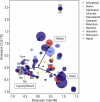Italian still life paintings as a resource for reconstructing past Mediterranean aquatic biodiversity
- PMID: 40897894
- PMCID: PMC12405436
- DOI: 10.1038/s44185-025-00103-8
Italian still life paintings as a resource for reconstructing past Mediterranean aquatic biodiversity
Abstract
Our study explores the use of Italian still-life paintings from the Early Modern Period (16th-18th centuries) as historical records of past Mediterranean aquatic biodiversity. Following an environmental history approach, we analysed taxonomic composition in paintings, first examining geographic and temporal variations shaped by technical and socio-cultural influences. After consideration of these factors, we performed a detailed ecological interpretation of depicted taxa. Our findings reveal a shift from freshwater to marine resource use, driven by evolving fishing practices and technological advances. Socio-cultural elements, such as culinary traditions, religion and aesthetics also strongly shaped species representation. We discuss ecological interpretation of the representation of vulnerable and emblematic Mediterranean species in light of climate change, overexploitation and species biogeography. Our research highlights the powerful role of paintings in reconstructing past exploited ecosystems, offering a unique perspective for informing contemporary conservation efforts.
© 2025. The Author(s).
Conflict of interest statement
Competing interests: The authors declare no competing interests.
Figures








Similar articles
-
Integrating plot-based methods for monitoring biodiversity in island habitats under the scope of BIODIVERSA + project BioMonI: Tree monitoring in Terceira, Tenerife and Réunion Islands.Biodivers Data J. 2025 Jun 23;13:e158423. doi: 10.3897/BDJ.13.e158423. eCollection 2025. Biodivers Data J. 2025. PMID: 40708791 Free PMC article.
-
Prescription of Controlled Substances: Benefits and Risks.2025 Jul 6. In: StatPearls [Internet]. Treasure Island (FL): StatPearls Publishing; 2025 Jan–. 2025 Jul 6. In: StatPearls [Internet]. Treasure Island (FL): StatPearls Publishing; 2025 Jan–. PMID: 30726003 Free Books & Documents.
-
Historical Plant Sales (HPS) database: Documenting the spatiotemporal history of plant sales in the conterminous U.S.Ecology. 2023 Jul;104(7):e4106. doi: 10.1002/ecy.4106. Epub 2023 May 31. Ecology. 2023. PMID: 37259174
-
Improving Energy Access, Climate and Socio-Economic Outcomes Through Off-Grid Electrification Technologies: A Systematic Review.Campbell Syst Rev. 2025 Aug 15;21(3):e70060. doi: 10.1002/cl2.70060. eCollection 2025 Sep. Campbell Syst Rev. 2025. PMID: 40822661 Free PMC article. Review.
-
A scoping review of tropical pioneer trees' roles for restoration and conservation management: Harungana madagascariensis (Hypericaceae) a widespread African species as a model.PeerJ. 2025 May 23;13:e19458. doi: 10.7717/peerj.19458. eCollection 2025. PeerJ. 2025. PMID: 40421372 Free PMC article.
References
-
- Kittinger, J. N., McClenachan, L., Gedan, K. B. & Blight, L. K. Marine Historical Ecology in Conservation: Applying the Past to Manage for the Future (University of California Press, 2015).
-
- Szabó, P. & Hédl, R. Advancing the integration of history and ecology for conservation: history, ecology, and conservation. Conserv. Biol.25, 680–687 (2011). - PubMed
-
- Iglésias, S. P. & Mollen, F. H. L’histoire de la description du squale bouclé Echinorhinus brucus (Bonnaterre, 1788) (Echinorhinidae) et la redécouverte des illustrations du type perdu. Zoosystema42, 173–193 (2020).
-
- Reeves, R. R., Smith, T. D., Josephson, E. A., Clapham, P. J. & Woolmer, G. Historical observations of humpback and blue whales in the North Atlantic Ocean: clues to migratory routes and possibly additional feeding grounds. Mar. Mammal Sci.20, 774–786 (2004).
Grants and funding
LinkOut - more resources
Full Text Sources
Miscellaneous

